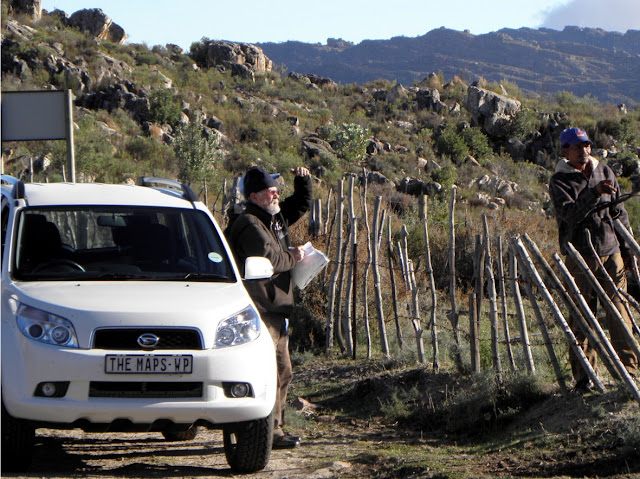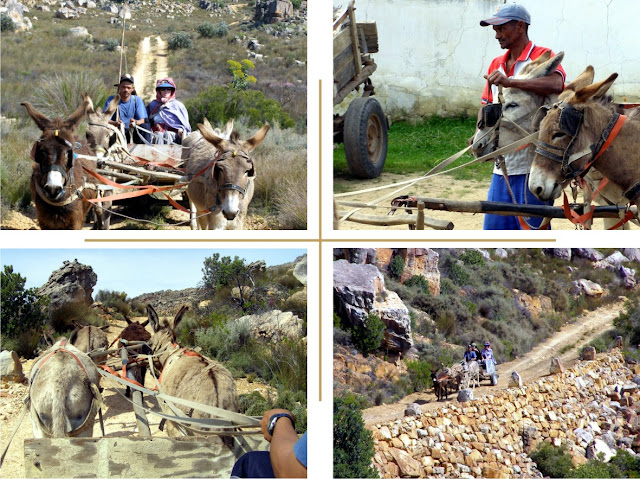Here it is at last: our first sample “bit of map”, ready and awaiting your critical inputs. Before I tell you how to find it, though, some explanations:
- The map-sample is a condensed jpg file, so do not expect all the line-work and lettering to be as sharp as the final printed product;
- colours may not be 100% true, depending upon your monitor settings;
- the original is approx. 1:50 000 scale. To reproduce this you need to print or view the map-sample at max. width of 200 mm;
- there is no key to the sample [there will be one, of course, on the complete map] so there may be some new symbols that are unfamiliar. Two purple cellphones with arrows pointing to each other indication reception over a path section, whereas a white cellphone means reception at that point only [if you’re lucky]. An upside-down yellow arrow means a bouldering site; a brown dotted line is a path used by boulderers; paths with CapeNature’s area are green dots, others are red. There are grades of path but only the standard “clear path” grade appears on the sample. If there is anything else you don’t understand please contact me at http://www.slingsbymaps.com/contactus.aspx
- A name in red means we have not located it accurately yet;
- there is only a long/lat grid on the map at this stage; there are requests for a UTM grid as well but I’m still working on how to do this without crowding the map too much;
- there are already two necessary corrections to the map – see below.
 |
| See link below to view or download the full-size version of the above |
Below are some pics and comments about the two day walks in the Kliphuis/Pakhuis area that appear on the map-sample, plus a bit more input on that controversial Kruisrivier “path”.
We will also publish a sample bit of a high mountain area a bit later – watch out for it.
View and/or download the map-sample from
The Pakhuisberg day walk starts from the Kliphuis campsite and climbs into the Pakhuisberg north of the Pakhuis Pass. It’s an easy walk over about 13.5 km of wild, infrequently-visited territory with great views, especially on the descent [I’m walking the circuit anti-clockwise].
Don’t rely upon perennial water, but there are some strong streams after winter. There is one cave-shelter on the path that could shelter two or maybe three people, but it’s not really an overnighting spot.
There are great flowers, the fascinating rocks that the Cederberg is famous for, and plenty of wildlife, even frequent leopard-sign.
 |
| Left to Right: A Phylica; an Erica; Leucospermum calligerum. Any offers on the names for the phylica and erica? |
The Rocklands day walk also starts at Kliphuis, but I’d recommend a clockwise-direction. It’s also a comfortable 13.5 km but you could take a short cut and cut out 3.5 km from your day, thus missing some interesting country. The path ascends the Rheboksvallei parallel to the tarred road, not too much of a problem as there is seldom much traffic.
Near the summit of the pass there is an interesting Kliphoutboom copse, and you briefly join the Noodpad, the “donkey-cart” road to Heuningvlei, before swinging west on Amon se Pad. The route follows the old wagon road over the Pakhuis that predates the modern pass, first built by Bain in 1867. It passes several popular bouldering sites before reaching Duiwel se Kruis, the cross-roads where the Boskloof path descends Amon se Poort to the left. A few hundred metres down the path to the right is a rock-shelter that could sleep up to three adults. It’s on the right of the path, not the left as the sample shows [the second correction!].
 |
| Clockwise from Top Left: 1. Fine waboom trees on the path 2. A typical Rocklands chockstone or window 3. Rough repairs to the old wagon-track 4. The Gate, the false non-entrance to Amon se Poort |
 |
| Left: Ancient rooibos tea bushes Right: Pyramid Rock |
Inputs
Not much info has come in since our successful name-gathering in the Wupperthal buiteposte, but we did get this letter from Louis Conradie – with more about that problematic Kruisrivier valley. I’m really unsure about how to deal with this on the map; any ideas, anyone?
I’m sorry I cannot reply to Louis – my system consistently rejects his email address, so please pass this on to him, those of you who know him. He writes [shortened]:
I led a group of 4 hikers on a 7 day CUM Hike-“expedition” doing a big circle starting from Algeria on 5 Sept. 2011 and finishing there again on 11 Sept. 2011. Only 3 of us finished the whole route as one lady pulled out during day 5 due to feet problems. The other two hikers who finished the route with me were David Rossouw and his wife, Karen, two very tough hikers, I must say!
On 10 Sept. 2011 we started from the Maltese Cross (where we slept the night of 9 Sept.), following the path to Bakleikraal and down into the valley of the Hekserivier past Riempie se Gat and Dons se Werf. We lost the path quite a few times, but kept direction as I had already hiked that route in 2008. On that hike in 2008 we wanted to take the path at the Kruisrivier which crossed over to Algeria, but somehow missed it and finished in the Pakhuispas [Nieuwoudt’s? - Ed] many kms later.
We could not reach the Kruisrivier before dark on 10 Sept. 2011, but on 11 Sept. easily found a path going upstream along the Kruisrivier, which was very motivating. But not for long! We soon experienced the same overgrown and almost impassable route as was already reported in your reports – in fact, there was no route at all. But we wanted to take that route to Algeria, so we struggled upwards in the kloof to the top, doing less than 1 km an hour! It was really bundu-bashing as I have not experienced at any time in my hiking career
When we arrived at the top of the Kruisrivier after our hectic struggle to get through and over everything, it was really a nice and easy hike down to Algeria.
I intend doing a 9 day hike in the Cederberg this year again, from 8-16 Sept., and am thinking of including the Hekserivier valley in the hike once again. Maybe CapeNature, especially Patrick Lane at Algeria, has sent out teams to clear that Kruisrivier path making it hikeable again. If not, our guts will again be tested to the limit!
Already acknowledged: Rudolf Andrag, Quinton Martins, Ronnie Hazell, Charles Merry, Ezan Wilson, Wim Morris, Alex Basson, Graham Bellairs, Julyan Symons, Galeo Saintz, Paul la Grange, Laurence Elton, Mike Scott, Peter Hart, Justin Lawson, Paul la Grange, David Donald, Johann Lanz, Cisca Nieuwoudt, Torben Wiborg, Sandy MacDonald, Trevor Rennison, Hendrico Burger, Nicky Lombard, Jeroen Kant, Patrick Lane, Ingar Valentyn, Pip Nieuwoudt, Eugene Moll, Greg Moseley, Tony Heher, Andrea and Moritz Connrad, Hennie van der Westhuizen, Isak Koopman, Kerneels Filander, Kellie of Grasvlei, Barry Ockhuis, Joey Ockhuis, Gert Theron, Mary Anne Zimri, Louis Conradie, Haffie Strauss
Let the comments come rolling in, asseblief ...
Kaartman, 19 June 2012











